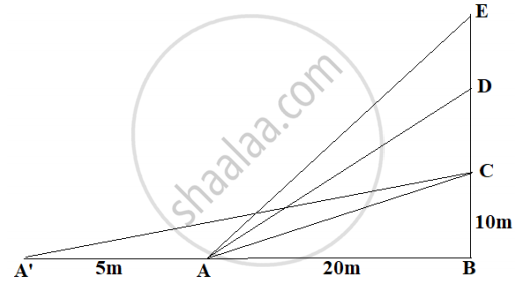Advertisements
Advertisements
Question
Prove that `3sin^(-1)x = sin^(-1) (3x - 4x^3)`, `x in [-1/2, 1/2]`
Solution
To prove `3sin^(-1)x = sin^(-1) (3x - 4x^3)`, `x in [-1/2, 1/2]`
R.H.S : `sin^(-1) (3x - 4x^3)`
Let `x = sin theta`
`=> theta = sin^(-1)x `
Putting this value of x in RHS, we get
`= sin^(-1) (3sin theta - 4sin^3 theta)`
`= sin^(-1) (sin 3theta)` `(∵ sin 3theta = 3sintheta - 4sn^3 theta)`
`= 3theta`
`= 3sin^(-1) x = L.H.S`
Thus, LHS = RHS
Hence Proved
APPEARS IN
RELATED QUESTIONS
If a line makes angles 90°, 60° and θ with x, y and z-axis respectively, where θ is acute, then find θ.
sin–1 (1 – x) – 2 sin–1 x = `pi/2` , then x is equal to ______.
Solve for x : \[\cos \left( \tan^{- 1} x \right) = \sin \left( \cot^{- 1} \frac{3}{4} \right)\] .
Solve: tan-1 4 x + tan-1 6x `= π/(4)`.
Find the value, if it exists. If not, give the reason for non-existence
`tan^-1(sin(- (5pi)/2))`
Solve: `tan^-1x = cos^-1 (1 - "a"^2)/(1 + "a"^2) - cos^-1 (1 - "b"^2)/(1 + "b"^2), "a" > 0, "b" > 0`
Choose the correct alternative:
If |x| ≤ 1, then `2tan^-1x - sin^-1 (2x)/(1 + x^2)` is equal to
Evaluate tan (tan–1(– 4)).
Prove that cot–17 + cot–18 + cot–118 = cot–13
Prove that `tan^-1 ((sqrt(1 + x^2) + sqrt(1 - x^2))/((1 + x^2) - sqrt(1 - x^2))) = pi/2 + 1/2 cos^-1x^2`
If 3 tan–1x + cot–1x = π, then x equals ______.
If `sin^-1 ((2"a")/(1 + "a"^2)) + cos^-1 ((1 - "a"^2)/(1 + "a"^2)) = tan^-1 ((2x)/(1 - x^2))`. where a, x ∈ ] 0, 1, then the value of x is ______.
If cos–1x > sin–1x, then ______.
Solve for x : `"sin"^-1 2 "x" + sin^-1 3"x" = pi/3`
`"tan"^-1 1/3 + "tan"^-1 1/5 + "tan"^-1 1/7 = "tan"^-1 1/8 =` ____________.
The value of `"tan"^-1 (1/2) + "tan"^-1(1/3) + "tan"^-1(7/8)` is ____________.
If `"tan"^-1 2 "x + tan"^-1 3 "x" = pi/4`, then x is ____________.
`"cos"^-1 1/2 + 2 "sin"^-1 1/2` is equal to ____________.
`"sin"^-1 (1/sqrt2)`
`"cos"^-1 (1/2)`
If `3 "sin"^-1 ((2"x")/(1 + "x"^2)) - 4 "cos"^-1 ((1 - "x"^2)/(1 + "x"^2)) + 2 "tan"^-1 ((2"x")/(1 - "x"^2)) = pi/3` then x is equal to ____________.
The Government of India is planning to fix a hoarding board at the face of a building on the road of a busy market for awareness on COVID-19 protocol. Ram, Robert and Rahim are the three engineers who are working on this project. “A” is considered to be a person viewing the hoarding board 20 metres away from the building, standing at the edge of a pathway nearby. Ram, Robert and Rahim suggested to the firm to place the hoarding board at three different locations namely C, D and E. “C” is at the height of 10 metres from the ground level. For viewer A, the angle of elevation of “D” is double the angle of elevation of “C” The angle of elevation of “E” is triple the angle of elevation of “C” for the same viewer. Look at the figure given and based on the above information answer the following:

Measure of ∠DAB = ________.
The Government of India is planning to fix a hoarding board at the face of a building on the road of a busy market for awareness on COVID-19 protocol. Ram, Robert and Rahim are the three engineers who are working on this project. “A” is considered to be a person viewing the hoarding board 20 metres away from the building, standing at the edge of a pathway nearby. Ram, Robert and Rahim suggested to the firm to place the hoarding board at three different locations namely C, D and E. “C” is at the height of 10 metres from the ground level. For viewer A, the angle of elevation of “D” is double the angle of elevation of “C” The angle of elevation of “E” is triple the angle of elevation of “C” for the same viewer. Look at the figure given and based on the above information answer the following:

𝐴' Is another viewer standing on the same line of observation across the road. If the width of the road is 5 meters, then the difference between ∠CAB and ∠CA'B is ______.
Find the value of `tan^-1 [2 cos (2 sin^-1 1/2)] + tan^-1 1`.
Solve:
sin–1(x) + sin–1(1 – x) = cos–1x.
